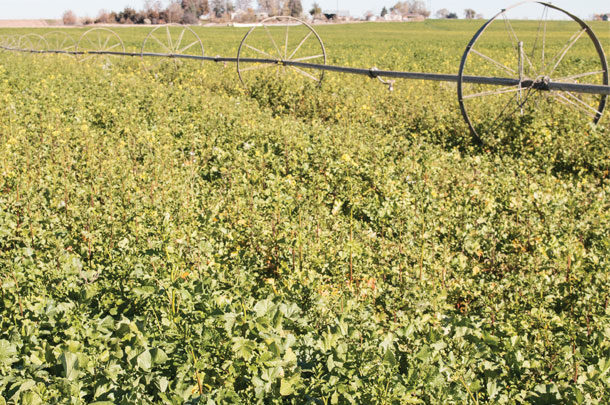But figuring out how you’ll end the cover crop life cycle in a clean cut in time for spring and summer planting has to come before you plant the first seed. Try to envision what you are trying to accomplish. If you want to maximize moisture uptake and dry out wet soil, for example, you will want to let the cover grow as long as possible and plant green into it. If you find your goal is to harvest the cover for forage, the primary consideration becomes to harvest at the most yield you can get at the best possible digestibility.
When spring rolls around, it presents its own set of challenges. Weather is cool, wet, and often unpredictable, making field operations tricky. Covers grow rapidly as they break dormancy at spring greenup, rebelling more each day against plans for easy control. As they begin to mature and lignify, they tie up more moisture and nutrients. And cool weather can greatly limit herbicide effectiveness. You find yourself in the position of trying to balance maximizing the cover crop against terminating it at the most opportune time.
Growing an overwintering cover crop can be a tall order, because you don’t have the ease of a winter-killed crop taking care of itself, or in the case of a summer annual, any volunteers getting easily knocked back by frost. A winter annual cover crop is going full steam ahead as spring takes off.
If it’s a mix, it can get even more complicated. You will have to consider what is required to kill each species in the mix. Timing is also important. To avoid tying up nitrogen, a grass cover crop should be killed two weeks before planting corn. And remember to think through a few backup options if Plan A doesn’t work out.
Tillage
Tillage can be an effective control method, with some caveats. It’s likely to be difficult or impossible in wet spring conditions, where it can cause compaction and soil structure damage. However, it tends to be more consistently effective than other cultural control methods, such as mowing, crimping or relying on winterkill.
If you wait for lots of biomass to grow (best to reap all those cover crop benefits), the crop can be messy and require several trips across the field to get the cover crop under control, depending on your tillage method. Multiple passes across the field may negate any soil health benefits achieved by the cover crop. The best bet is often to combine tools, such as spraying early and using a vertical tillage tool.
Reduced tillage systems without the use of herbicide generally won’t provide full control of the cover crop. Inversion tillage (moldboard plowing) is the best bet for total suppression, but for organic farmers and those who want to cut back on chemicals, there are still a variety of options in the toolbox (these work best to kill mature, flowering, annual cover crops that don’t readily regrow after suppression):
- Spading machine: This leaves no risk of dead furrow and breaks up soil to allow for better drainage and air penetration. If you have small amounts of residue or biomass, spading machines create a ready-to-use field in one pass, without the need for disking, plowing or harrowing.
- Mow followed by shallow, noninversion tillage
- Sweep plow undercutter: This undercuts and disturbs the top layer of soil.
- Relying on winterkill (Do your research about the temperatures and conditions needed to kill your cover crop.)
- For no-till or strip till, a roller-crimper or flail mower: Since flail mowers chop residue finely, they create a nice surface mulch from the cover crop that will break down quickly. The flail mower also allows you to get within ¼-inch of the soil surface, creating a uniform kill for most species.
Herbicide
In spring, you will have to contend with cool temperatures and a dense canopy of rapidly maturing plants. Contact herbicides won’t be as effective on overwintering cover crops because plants are large and growing quickly, and you’ll need 100 percent coverage. Glyphosate is much more effective in this scenario because it translocates to the plants’ growing point and root system. Glyphosate is also better at earlier growth stages, especially before rye reaches boot stage.
Cover crop species respond differently to herbicide, especially at different points in their growth. Annual ryegrass is notoriously hard to kill. By spring, it has developed a strong root system, robust top growth and a waxy, protective texture to the leaves. Ryegrass must be actively growing for glyphosate to translocate throughout the plant, yet should also be sprayed before the first node develops.
Know the planting restrictions of the herbicide you’re working with: Will these affect the cash crop? A safe bet is any product labeled for burndown or pre-plant for the following crop. Avoid herbicides with residuals if you plan on interseeding.
You will have to pay close attention to temperature and rates for top herbicide effect. Use the right rate for the height and growth stage of the crop. Glyphosate needs three days of temperatures no cooler than 45ºF, with daytime temperatures between 55 and 60ºF.
Other strategies
Cereal rye, another staple cover crop known for its flexibility in late planting, is also flexible when it comes to termination. Some growers kill it at 12 inches, others let it reach 6 feet tall. Again, the earlier it’s terminated, the better the chance of success. If you’re new to using cover crops, err on the side of an earlier kill. Killing at greenup provides a very low risk, and it keeps the biomass small and limits soil moisture uptake. Past about 18 inches tall, planting equipment will have to be adjusted to handle the greater biomass. Spoked closing wheels also help in closing the seed slot in the dense root mass.
Closer to maturity, rye also offers options to play with timing, lending itself better than other cover crops to rolling-crimping and planting green. These practices maximize biomass and thatch when rolled down. In a dry year, this thatch layer can be a huge benefit in conserving soil moisture. Use of a roller-crimper allows you to leave the cover crop growing right up until planting time and get the most out of the cover crop, especially in the weed suppression department. Rolled rye and other small grains (barley and triticale also work well) pair best with a soybean planting. Whether you’re rolling small grains or hairy vetch, you’ll want to wait until flowering (full bloom for annual legumes) to roll-crimp to ensure kill. Supplementing rolling with herbicide is also quite effective. Cover crops alone may not always be enough for weed control, but can be quite powerful in combination with herbicides.
Winterkill
Letting the cold temps take care of the cover crop can certainly save you some work and anxiety. Look for crops that won’t overwinter in cold climates, such as oats, spring barley or wheat, radish, many other brassicas, and even summer annuals like sorghum-sudan, buckwheat and cowpeas. Maturity makes a difference in winterkill, so getting these crops planted at the proper time makes the process go smoothly.
For example, a more mature radish has its growing point higher above the ground, leaving it more exposed to winterkill. Leave adequate time for growth before the average frost date. The climate of your location is also very important – many of these crops will successfully overwinter in Southern growing zones. Generally, if temperatures stay around 15ºF for several days, these species will die off.
Timing
The weather plays a major role in planning timing. If it becomes clear that a dry spring is making moisture a limiting factor, don’t let the cover crop grow in a dry spell with no rain in sight, especially as you get into your primary planting window. You may end up spraying earlier so your cover doesn’t use up moisture needed for the next crop.
Other risks with late termination, besides excessive water use, include the sequestration of plant-available nutrients and excess residue that can make planting difficult.
Be sure to check with your crop insurance agent for cover crop termination requirements before planting the following crop – a certain time window before planting may be required.
Keep an eye on it
Following termination, give it two weeks, and be sure to check the field for regrowth or skipped areas. The sooner you catch it, the more time you save yourself during planting season.
When planning when and how to kill your cover crops, it’s helpful to have a multipronged approach that combines strategies (such as mechanical control with herbicides), and of course, a backup plan. ![]()
PHOTO: The best bet is often to combine tools, such as spraying early and using a vertical tillage tool. Photo by Lynn Jaynes.
Genevieve Slocum is a freelance writer based in Pennsylvania. Email Genevieve Slocum.











